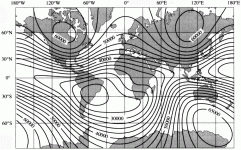sea.thunter7
Jr. Member
- #1
Thread Owner
Does anyone have a platinum frequency they're willing to share?
NMR is 21.4MHz. Calculated to my area(FL) that's 222Hz at the moment. It can have a baseline of 80 to 380Hz depending on the time of day, location and EFNMR.
No the frequency rises going from the equator to the poles. About 1.5x higher in Wyoming. Platinum frequency is also temperature dependent. Its frequency rise as ambient temperature rises. As much as 10hz per degree F in real world EFNMR testing. This also changes depending on what element is used for proton bonding and how coupling is calculated for mean and median. In real life there is no cut and dry frequency that is the perfect answer. Testing a close frequency and tuning it to a sample is the best metaphysical determination of what works.

All of this would be valuable information if it could be applied to remotely detecting platinum through its precession frequency. But NMR doesn't work that way, and the best you can do is pretend it's useful while playing with make-believe treasure hunting equipment. If 2 or 3 big empty holes don't convince you, try a few more.
So it would be wise to keep an open mind and truly explore the possibilities.
NMR tables are usually normalized to H=100MHz, which is a field strength of 2.35T. Precession frequency is pretty linear with field strength, at least with most elements, so even at 25uT you can get a pretty close number. Hydrogen-based proton magnetometers easily demonstrate this. Here is a plot of the Earth field:
View attachment 1647003
The field strength in the Philippines is around 40nT, so platinum has an NMR frequency of around 456 Hz.
All of this would be valuable information if it could be applied to remotely detecting platinum through its precession frequency. But NMR doesn't work that way, and the best you can do is pretend it's useful while playing with make-believe treasure hunting equipment. If 2 or 3 big empty holes don't convince you, try a few more.
Macro, it seems you're pretty new around here. I've been investigating LRLs and dowsing for 20 years now, accumulated quite a few devices, and tested a fair number of people who claim they can dowse. I even offered $25,000 to anyone who could successfully demonstrate an LRL in a really simple scientific test; how's that for open minded? In 20 years, I've never seen a single person succeed. They all fell flat on their face, and then wondered what the heck happened. Refusing to consider that it never worked in the first place.
I'm still open-minded enough to offer anyone who disagrees the opportunity to prove me wrong, and you can see from other forums that there are plenty of people who disagree with me. But while they can talk the talk all day long, they don't wanna walk the walk; it would be a major embarrassment if they couldn't actually do what they say they can do. So they go on pretending it works, which is fine with them and fine with me. Sea.thunter7 will likely take his new platinum frequencies, dig another 80-foot-deep hole, and wind up with nothing but a pile of dirt. Like all the other Philippine treasure hunters who dig holes all over the place, but have nothing to show for their efforts but holes all over the place.
When you put in the effort to understand why your dowsing rods seem to respond to an imaginary signal line you think you've created to that copper tubing, then you will understand dowsing in general, and may not be so open-minded that you'll accept at face-value all the made-up nonsense that surrounds it. Or, pretend to be a Big Time Treasure Hunter and go dig a bunch of holes.
Searching "195pt nmr—theory and application" and "Temperature dependence of platinum-195 nuclear resonance chemical shifts" will get anyone ho actually cares a primer.
That paper concerns platinum compounds, not platinum-the-metal. Completely different scenario.
Well, thank you for sharing your infinite wisdom on the topic. I remember speaking to someone who had been fighting in Afghanistan or somewhere else in the middle-east. They said that the military had been using L-rods to dowse for landmines over there. Can anyone confirm this? Well anyway. Most of us probably have enough doubt about whether dowsing works already. No reason to sit here and debate it further.
But since we probably won't agree on NMR research, I think we can still agree it's a completely useless scenario for LRL operation.
Of course. In a proton mag, the hydrogen sample is placed inside the TX and RX coils, any attempt to measure precession frequency remotely (as in an inch away) would completely fail. And compared to hydrogen, metals have abysmally low receptivity, making them way harder to detect. It's a pretty silly concept that a dowsing rod would respond to this.
